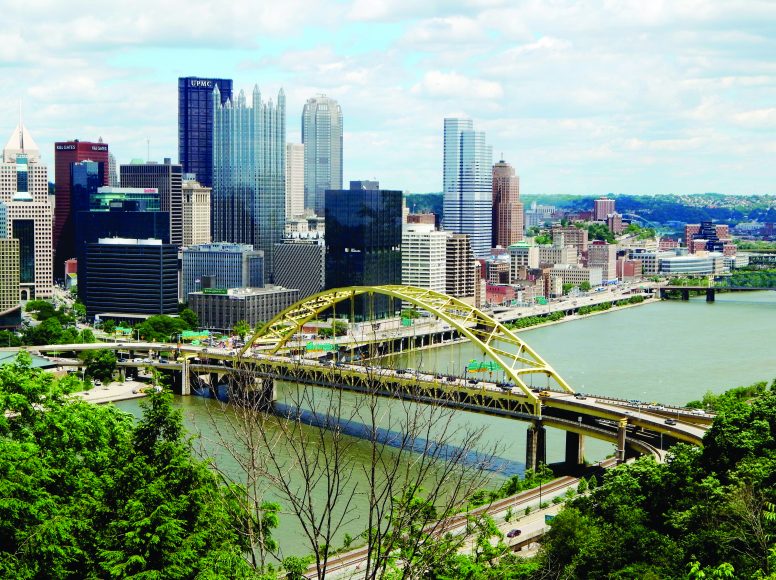Once a smoky city of heavy industry where the skies were darkened with soot at midday, Pittsburgh has emerged as a post-industrial metropolis committed to sustainability, green building and new urbanism. Creative Pittsburghers have redefined the city’s economy through technology, design and adaptive reuse.
Known both as “Steel City” for its more than 300 steel-related businesses and as “City of Bridges” for its 446 bridges, Pittsburgh is now defined as much by the arts. The city’s commitment to culture, paired with internationally acknowledged sustainable practices, is among the reasons Pittsburgh is recognized as one of the world’s best places to live and visit.
Indeed, Travel + Leisure has named the city one of the best places to travel. Zagat has rated it the nation’s number one food city and TripAdvisor calls it one of the top destinations on the rise. Worth checking out, I’d say.
Hometown boy
Among this city’s biggest draws — outstanding attractions, amenities, award-winning restaurants, world-class accommodations, and affordability. Oops, one more, Andy (Warhol, that is), Pittsburgh’s very own son, famous for way more than just 15 minutes.
Whether or not you’re a fan of Warhol’s marriage of commercial and high art, the Andy Warhol Museum merits a visit. It is one of the four Carnegie Museums of Pittsburgh and on its seven floors there are drawings, prints, paintings, sculptures, films and videos, as well as an extensive archive of ephemera, source material and other documents from the artist’s life. The Warhol Museum also features work by other artists, performances, special exhibitions, film screenings, lectures and concerts. Another provocative museum is The Frick Pittsburgh, where “A Sporting Vision” is on view through Sept. 8.
I followed my time at The Frick with a visit to the towering, elevated site of the Duquesne Incline that boasts “139 years and climbing.” At the top of Mount Washington there’s a cable car station with finely restored cars used by commuters since 1877. At this lofty perch one can experience the impressive Pittsburgh skyline and then smoothly descend to earth — up close and personal with the bustle and beauty of Pittsburgh today.
Gilt, glamour and gardens
However, the Pittsburgh of early 20th century was pretty darn awe-inspiring, as well. The Frick Art & Historical Center is on 5 acres of beautifully landscaped lawns and gardens. I toured Clayton, the meticulously restored home of the Henry Clay Frick family, with an inside view of day-to-day life at the turn of the 20th century and a stunning array of decorative arts, of which more than 90% are original. A superb way to enjoy the grounds of The Frick is at one of its Summer Fridays. There are free performances in the gardens with such diverse programs as ballet, food trucks and a dance party. Isn’t summer swell?
Sports town
And now a shout-out to sports in Pittsburgh, a place where it seems fans are just a wee bit more dedicated, a tiny bit crazier and above all, die-hard to the end. Sports in Pittsburgh have been played dating from the American Civil War. Baseball, hockey and the first professional American football game had been played in the city by 1892. Pittsburgh was first known as the “City of Champions” when the Pirates, the Panthers and the Steelers won multiple championships in the 1970s. Today, the city has three major professional sports franchises, the Pirates, Steelers and Penguins.
These accomplishments and others helped Pittsburgh earn the title of “Best Sports City” from Sporting News. Sports writer Jeff Hartman defines a die-hard Steelers fan as someone who knows the team totally, can talk at length about the battle at right tackle, knows who used to play that position, their compensation and who is among those vying for the one vacant spot on the Steelers’ offensive line. Of course, the number of jerseys one owns, if you have a ton of Steelers garb on your vehicle, having a man cave with Steelers stuff in it or getting a Steelers tattoo also counts.
Green scene
But Pittsburgh has also made environmentalism something of a competitive sport as well as an art, as the Re-NEW Festival showed in 2016. It was a citywide celebration of creative reuse, transformation and sustainability lasting a whole month. A key component of the event was the North American premiere of Drap-Art, the international festival of recycling art held annually in Barcelona, Spain. This set the stage for dynamic programming, including art exhibits within conventional galleries and alternative urban spaces, immersive public art and tours of reclaimed industrial sites. Markets of upcycled goods, films, performances and environmental trade expos showcased the festival’s themes of creative recycling and transformation. How fitting that this event happened in Pittsburgh, a notable and important expression of just how far this city — mighty and beautiful — has evolved.
For more, go to visitpittsburgh.com.


